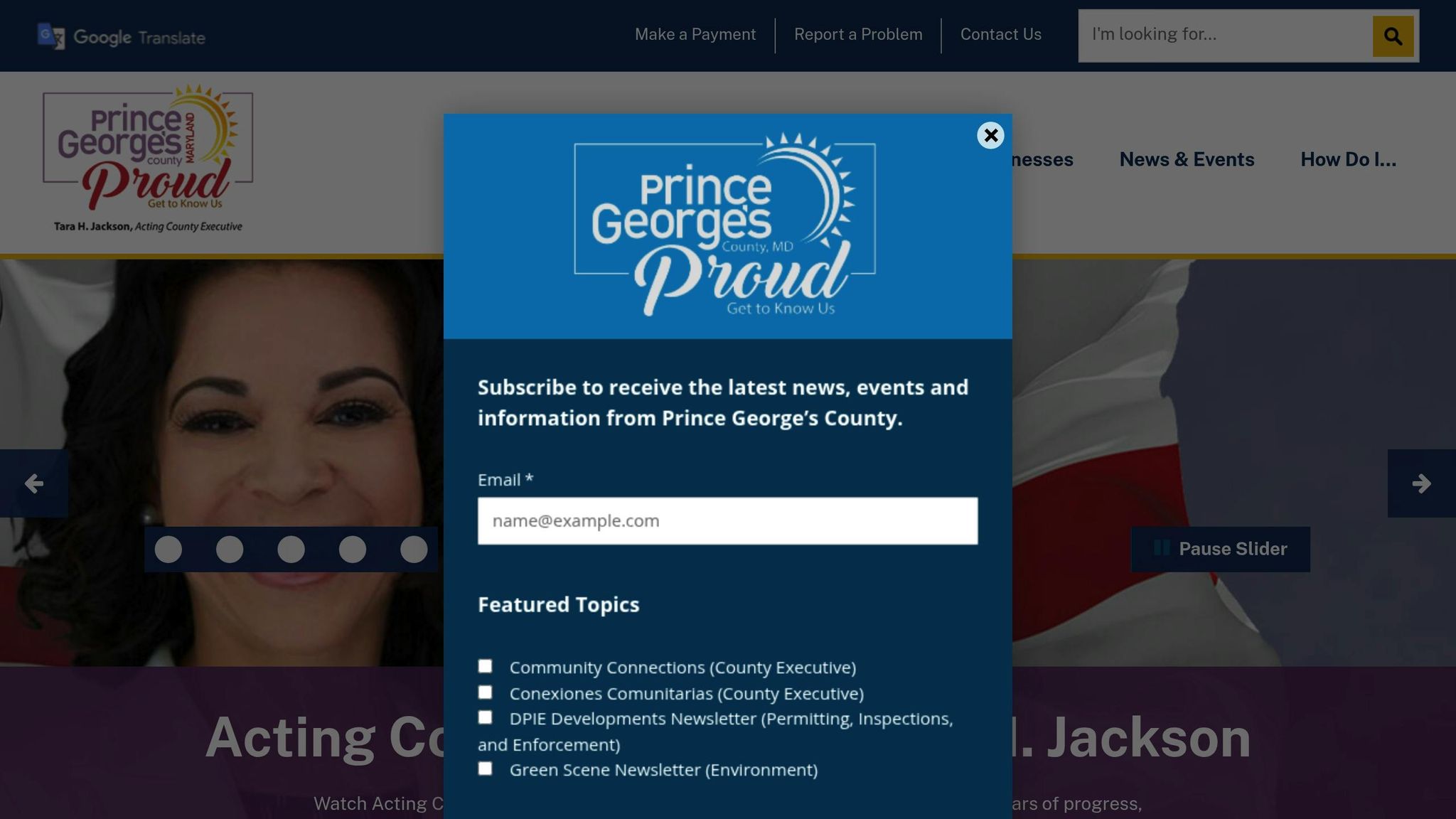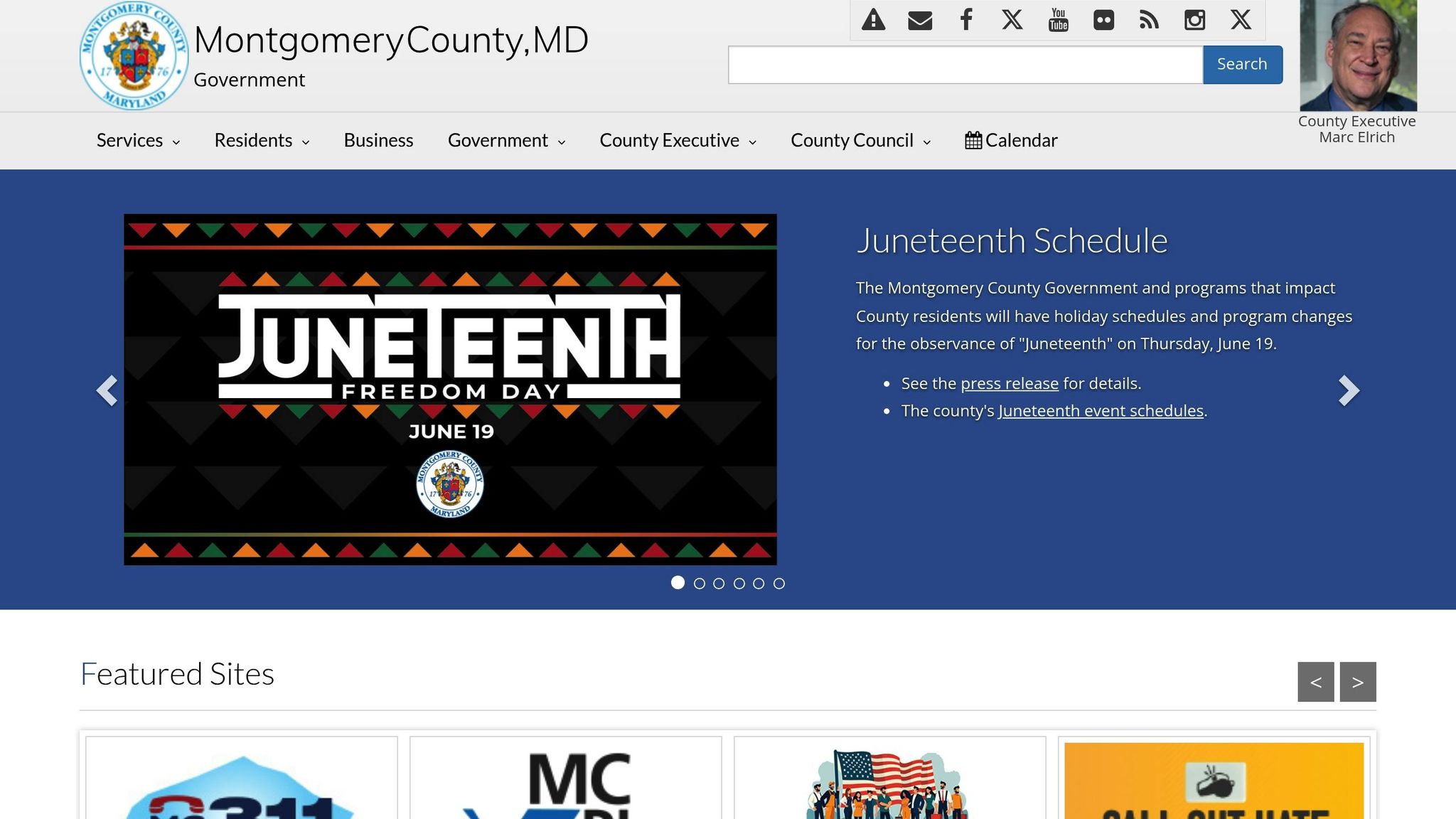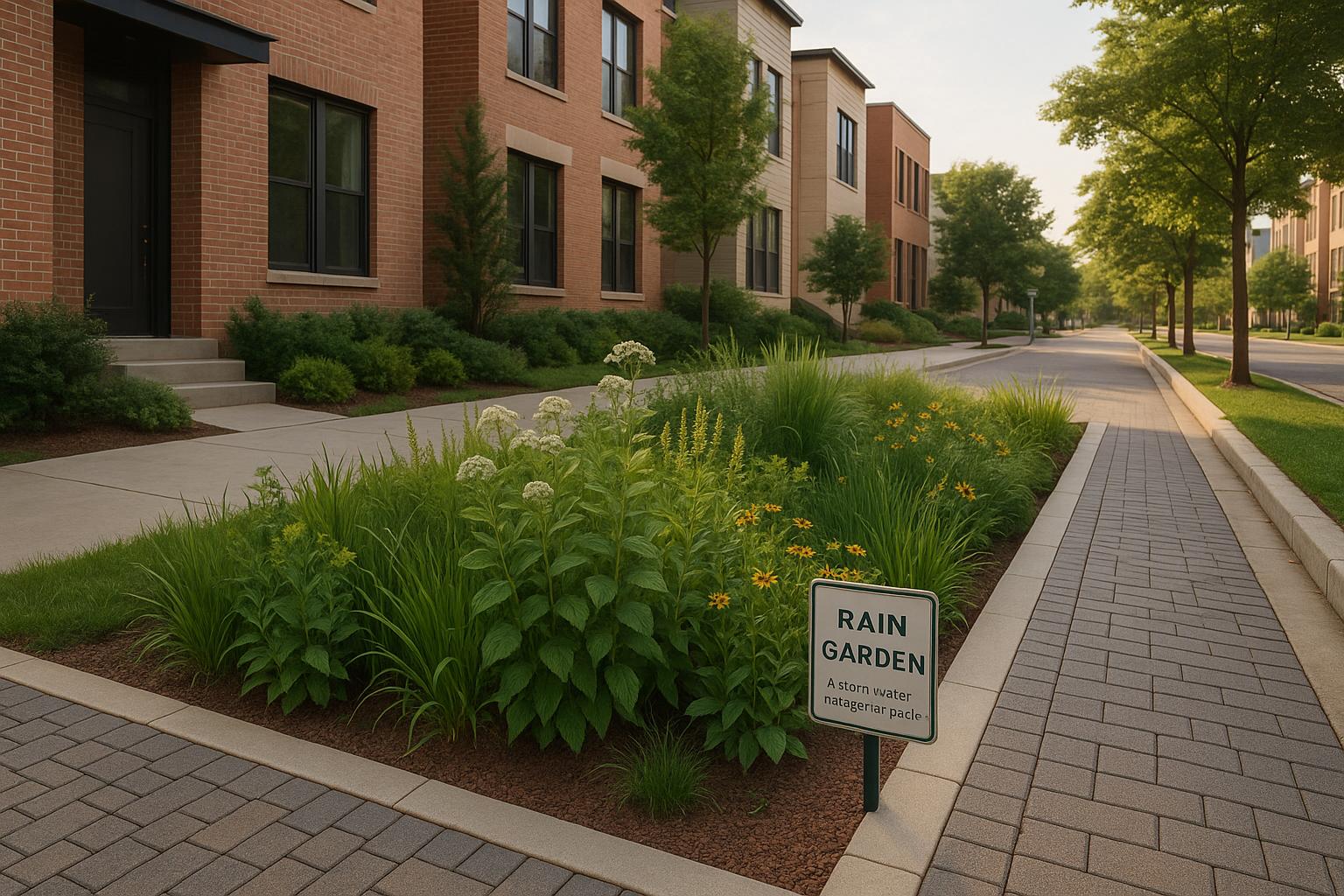- bhavya gada
- No Comments
Green stormwater retrofits are updates to surfaces like roads and parking lots that help manage rainwater naturally, reducing pollution and preventing flooding. Maryland has prioritized these systems to protect the Chesapeake Bay and meet federal water quality standards. Here’s a quick overview:
- Why It Matters: Maryland faces stormwater challenges that harm waterways, including the Chesapeake Bay. Retrofits reduce runoff and pollution while improving water management.
- Popular Solutions: Rain gardens, permeable pavements, green roofs, and bioswales are effective options.
- Regulations: Maryland’s 2007 Stormwater Management Act requires new developments to use eco-friendly designs. Permits and compliance with state and federal rules are essential.
- Financial Support: Tax credits and rebate programs are available to help offset costs for property owners.
- Maintenance: Regular inspections and upkeep are required to keep systems effective and compliant.
These retrofits not only help the environment but also reduce flooding, improve infrastructure, and create economic opportunities. Whether you’re a property owner or part of a larger project, understanding Maryland’s rules and resources is key to success.
Maryland’s Regulatory Framework for Green Stormwater Retrofits
State and Local Stormwater Regulations
Maryland’s approach to managing stormwater runoff is rooted in the Maryland Stormwater Management Act of 2007. Since May 2010, this law has required all new developments to use Environmental Site Design (ESD) principles to the Maximum Extent Practicable. The goal? Address stormwater runoff issues while meeting the standards of the federal Clean Water Act [5][6].
The Maryland Department of the Environment (MDE) has introduced updates under the A-StoRM initiative. These updates aim to strengthen ESD requirements, incorporate revised rainfall data, and improve flood management strategies [5]. On the local level, jurisdictions enforce their own stormwater regulations. For instance, Anne Arundel County implemented its Stormwater Management Regulations in November 2010, with MDE approving the program the following year [6]. Non-compliance with these regulations can lead to penalties, delays in permitting, or required corrective actions [5]. All green infrastructure projects must align with both state and local standards.
NPDES and MS4 Permits Explained
The National Pollutant Discharge Elimination System (NPDES), created under the Clean Water Act, regulates pollutant discharges by issuing permits. Across the country, about 7,250 Municipal Separate Storm Sewer Systems (MS4s) are required to implement comprehensive Stormwater Management Programs. These programs focus on pollution prevention, treatment, monitoring, and enforcement measures [7]. Federal requirements under NPDES work alongside Maryland’s state regulations to ensure that green stormwater retrofits help improve water quality.
How to Get Permits for Green Infrastructure Projects
Securing permits for green infrastructure projects in Maryland requires careful planning and coordination with various agencies. Start by preparing a Stormwater Pollution Prevention Plan (SWPPP) and submitting a Notice of Intent (NOI). These should include detailed erosion control, sediment management, and stormwater plans. In counties like Prince George’s, you’ll need to coordinate with multiple entities, such as the Department of Permitting, Inspections, and Enforcement (DPIE), County Health, the Maryland-National Capital Park and Planning Commission (M–NCPPC), and the Soil Conservation District [8][9][11]. Reaching out to your local permitting office early can help streamline the review process.
For construction projects, a building permit is generally required. Even smaller projects on waterfront properties – like patios, driveways, or retaining walls under 200 square feet – must comply with Maryland’s State Critical Area Laws [10]. Submitting a complete permit application early and consulting with local agencies can help avoid delays [10].
Once permits are approved, it’s crucial to follow the conditions outlined in the SWPPP. This includes regular maintenance activities like inspections, sediment removal, and vegetation management to keep the stormwater system functioning effectively. Incorporating updated rainfall data and design standards into system upgrades can also support long-term compliance [5]. By securing the necessary permits and adhering to these guidelines, green stormwater projects can deliver environmental benefits while staying fully compliant with regulations.
How to Implement Green Stormwater Retrofits
Choosing the Right Green Infrastructure Solutions
Green Stormwater Infrastructure (GSI) uses natural processes to manage stormwater runoff effectively. The key to success lies in selecting solutions that align with your site’s conditions and meet regulatory guidelines [12].
One popular option for residential areas is rain gardens. These are about 30% more absorbent than a standard lawn and can be tailored to local conditions [3]. They’re especially effective in managing runoff from impervious surfaces like driveways and rooftops.
Permeable pavements are another excellent choice, particularly for driveways, walkways, and parking areas. These surfaces allow water to seep through rather than running off, which helps reduce the amount of stormwater reaching waterways [12]. This solution is particularly useful in commercial spaces where traditional pavement contributes heavily to runoff.
For handling larger volumes of water, vegetated swales and dry riverbeds offer practical and visually appealing drainage options. These features channel runoff away from infrastructure and into areas designed for water absorption and habitat improvement [1].
In urban areas with limited ground space, green roofs can be a game-changer. They can retain between 40% and 80% of the rain that falls on them [3]. While they may be more complex to install, their ability to manage stormwater in constrained spaces makes them worth considering.
Combining several GSI practices often yields the best results. Well-designed systems can capture runoff from up to 95% of rainfall events [12]. Additionally, traditional stormwater ponds reduce total suspended solids (TSS) by 40%, while Regenerative Stormwater Conveyance (RSC) systems achieve up to a 60% reduction in TSS [12].
After choosing the right strategies, the materials you use can significantly impact the system’s effectiveness.
Using Eco-Friendly Materials
Materials play a crucial role in making GSI systems both effective and sustainable. For example, environmental pavers not only allow water infiltration but also provide durable and attractive hardscaping options.
Native vegetation is another cornerstone of successful GSI projects. These plants are naturally suited to local soil and rainfall conditions, reducing the need for maintenance while supporting local ecosystems. Incorporating native species into rain gardens and vegetated areas ensures long-term performance and helps cut down on upkeep costs [12].
Soil amendments can further boost water absorption and system efficiency. Properly prepared soil improves infiltration and supports healthy plant growth, ensuring that bioretention areas and rain gardens remain effective over time [12].
When selecting materials, it’s essential to prioritize those that direct runoff into designated areas for absorption while also meeting regulatory standards [1]. Sustainable design principles should guide every decision, from material durability to their environmental impact.
Once the materials are chosen, professional expertise is key to proper implementation.
Working with Professional Contractors
Green stormwater retrofits often require specialized knowledge in design, installation, and maintenance. Partnering with experienced professionals ensures the process goes smoothly and meets all regulatory requirements.
The first step is a thorough site assessment. Skilled contractors evaluate your property to determine which GSI solutions will work best [12].
Permitting can be another hurdle, but experienced contractors can simplify the process by navigating the complex requirements on your behalf [12].
Proper installation is critical. Whether it’s permeable pavers, bioretention areas, or drainage systems, professional installation ensures the system operates as intended. Regular operation and maintenance (O&M) are also vital for long-term performance [12].
For instance, Pro Landscapes MD specializes in stormwater management solutions in central Maryland. Their expertise includes installing environmental pavers, creating dry riverbeds, and designing drainage systems that address water challenges without compromising landscape aesthetics. They also handle essential tasks like French drain installation, grading, and yard repair – key components of effective GSI retrofits.
Long-term maintenance is just as important as installation. Professional contractors can establish maintenance schedules, conduct regular inspections, and perform necessary repairs to ensure systems continue to meet regulatory standards [12].
As Annie Richards, Chester Riverkeeper, puts it: "Leveraging private investments to help tackle urban runoff is a strategy that will likely become more powerful as we get closer to the 2025 deadline for the Chesapeake Bay Cleanup" [13].
MDE Guidance For Protecting Stormwater Best Management Practices During Construction November 2023
sbb-itb-843f8be
Maryland Green Stormwater Retrofit Case Studies
Maryland’s efforts in green stormwater retrofits highlight the practical application of advanced infrastructure standards. These case studies provide a clear picture of how these initiatives deliver both environmental improvements and economic benefits.
Prince George’s County Clean Water Partnership

In March 2015, Prince George’s County embarked on a 30-year initiative called the Clean Water Partnership (CWP), aiming to retrofit approximately 15,000 acres by 2025 [4]. By March 2025, the program had completed 428 sites, covering 4,658 credit acres [16]. To date, $326.3 million has been spent, with $256 million directed toward local and minority business participation [16].
The county has tackled stormwater runoff by capturing the first inch from 90% of storm events, reducing pollutants such as nitrogen by 50%, phosphorus by 40%, and sediment by 80% [4]. Maintenance efforts have also removed 167,951 pounds of trash from the system [16].
Beyond environmental gains, the program has spurred job creation, generating an estimated 5,000 jobs [4]. It also includes a Schools Program, which has invested $1.67 million in educational initiatives for students [16].
Neil Weinstein, Executive Director of the Low Impact Development Center, praised the program, stating:
"Corvias Solutions and the Clean Water Partnership has brought new energy and increased momentum to retrofitting older areas of Prince George’s County on a significant scale" [16].
Adam Ortiz, Director of the Department of the Environment for Prince George’s County, emphasized the program’s broader goals:
"This wasn’t just about meeting a mandate and this wasn’t just about stormwater. This was about community development. So we tried to engineer this program to be an economic driver, to help build a new industry in Prince George’s County that can be used everywhere" [16].
Montgomery County Water Management Projects

Montgomery County takes a different approach, focusing on targeted projects and incentive programs. The county uses stormwater facilities designed to slow and store runoff while encouraging ground infiltration, reducing pollution in local waterways [15]. For example, the Holiday Park Senior Center underwent a stormwater system renovation featuring bioretention planting designs [15].
The county’s Rainscapes program incentivizes private property owners to adopt green infrastructure. It offers $10 per square foot of garden area (minimum 75 square feet) as a rebate for rain garden projects [14]. Residential properties can receive rebates of up to $2,500, while commercial, multi-family, and institutional properties can qualify for up to $10,000 for stormwater retrofits [17].
These examples illustrate that successful green stormwater retrofits require both large-scale strategies and localized community engagement. Prince George’s County showcases how public-private partnerships can address extensive challenges while spurring economic growth. Meanwhile, Montgomery County demonstrates how targeted incentives can encourage widespread adoption of sustainable practices.
Together, these counties highlight the measurable environmental improvements and economic opportunities that green stormwater retrofits can bring, serving as valuable blueprints for other Maryland communities following state and local guidelines.
Compliance and Maintenance Requirements
Once a stormwater system is designed, permitted, and installed, the work doesn’t stop there. Regular maintenance is essential to keep the system functioning properly and to meet regulatory requirements. Simply put, installation is just the first step – ongoing upkeep ensures the system performs as intended and stays compliant.
Staying Compliant with Regulations
Stormwater systems must be designed and maintained to meet both Maryland and federal Clean Water Act standards [18]. Failing to comply can lead to fines, mandatory corrective actions, and delays in obtaining permits [18].
In Montgomery County, stormwater Best Management Practices (BMPs) are inspected every three years [19]. The county is divided into three regions, with inspections rotating through each region on a rolling schedule [19].
Routine inspections play a critical role in catching minor issues before they turn into major problems. Property owners are notified if their systems need attention, and addressing these concerns quickly can save money on more extensive repairs down the line. Additionally, keeping up with evolving design standards and updated rainfall data is key to ensuring systems remain effective [18].
Consistent maintenance is just as important as compliance, and the two go hand in hand.
Maintenance Requirements and Tips
Stormwater BMPs require annual maintenance to function efficiently [19]. Maintenance responsibilities depend on ownership – county-owned BMPs are serviced by DEP contractors, while private property owners are responsible for maintaining systems on their land [19].
Here are some of the essential maintenance tasks:
- Removing sediment and debris
- Managing vegetation growth
- Repairing signs of erosion
- Addressing prolonged standing water [19]
Unscheduled maintenance may be needed if issues like excess sediment, trash buildup, overgrown or dead vegetation, erosion, structural damage, or standing water (lasting more than 72 hours after rainfall) are identified [20].
Maintenance plans vary depending on the type of green infrastructure project, so it’s important to understand the specific needs of your system. Partnering with a professional stormwater management company can help you identify potential problems early and avoid costly repairs. This approach not only ensures compliance but also extends the life of your system.
For property owners, financial programs are available to help offset the costs of retrofits and maintenance.
Financial Incentives and Cost Assistance
Many Maryland counties offer programs to ease the financial burden of maintaining and retrofitting stormwater systems. For example, Anne Arundel County provides a property tax credit of 10% of retrofit costs, capped at $10,000 over five years [22][23].
Prince George’s County previously offered the Rain Check Rebate Program, which provided rebates for eco-friendly projects like rain barrels, rain gardens, permeable pavement, and green roofs [21]. However, this program is proposed to be paused for FY26, spanning from July 1, 2025, to June 31, 2026 [21]. The county’s Urban Tree Program remains active, offering reimbursements of $300 for each native tree (2–2½ calipers or larger) planted in underserved areas [21].
Additionally, the Maryland Chesapeake and Atlantic Coastal Bays Trust Fund offers Local Implementation Grants for stormwater retrofit projects. However, these grants are generally aimed at local governments and nonprofits rather than individual property owners [22].
For those needing expert guidance, professionals like Anne Guillette at the Low Impact Design Studio can help with everything from assessments and planning to construction and grant applications [22].
Pro Landscapes MD provides a full-service approach to stormwater management, handling everything from installation to ongoing maintenance. Their expertise ensures systems across central Maryland remain effective and compliant for the long term.
Conclusion
Green stormwater retrofits provide Maryland property owners with an efficient way to manage stormwater while benefiting the environment, economy, and local communities. These systems work by capturing and filtering runoff, reducing its impact, and aligning with nature’s processes to address stormwater challenges effectively [24].
Key Points to Remember
Sustainable stormwater management relies on thoughtful design and adherence to regulations. Green infrastructure replicates natural systems by managing rainwater where it falls, offering solutions that reduce flooding and enhance neighborhood appeal [25]. Here are some of the standout benefits:
- Environmental benefits: These systems slow, absorb, and filter stormwater at its source, reducing the need to divert water elsewhere [25].
- Community advantages: Projects foster neighborhood engagement and help counteract the economic toll of flooding [24][25].
- Economic opportunities: Maryland has invested heavily in green infrastructure, with Prince George’s County aiming to retrofit 15,000 acres by 2025 [2][27].
- Regulatory compliance: Property owners can meet legal requirements while exploring tax credits and financial incentives [26].
"Green infrastructure projects are one of those rare win-win-win scenarios: They improve communities in various ways, they improve human health, and they also benefit our waterways."
- Dr. Jana Davis, President of the Chesapeake Bay Trust [27]
Maryland’s regulatory framework supports these efforts by offering clear permitting processes and guidelines, ensuring that property owners can maintain the effectiveness of their systems over time. By integrating green infrastructure into stormwater projects, communities can transform traditional "gray" systems into eco-friendly solutions [25].
With the right expertise, these initiatives can deliver enduring environmental and community benefits.
How Pro Landscapes MD Can Help

Pro Landscapes MD specializes in comprehensive green stormwater retrofit solutions throughout central Maryland. Their services ensure regulatory compliance, enhance outdoor aesthetics, and promote sustainable practices.
From initial design and permitting to installation and ongoing maintenance, Pro Landscapes MD handles every step of the process. With a deep understanding of Maryland’s regulatory landscape, their team helps property owners maximize the functionality of green infrastructure while meeting all compliance requirements.
FAQs
What challenges do property owners in Maryland face when implementing green stormwater retrofits?
Property owners in Maryland face a range of obstacles when working on green stormwater retrofits. One major challenge is securing enough funding to get projects off the ground. On top of that, understanding the specific conditions of their site and designing solutions that align with regulatory standards can be overwhelming. Balancing project costs with deadlines adds another layer of complexity, especially when factoring in the need for long-term upkeep.
Other difficulties include dealing with increasing project expenses, staying compliant with local regulations, and ensuring systems are maintained to function as intended over time. Even with these hurdles, green stormwater retrofits offer clear environmental advantages and can boost property value when done right.
What financial assistance is available for green stormwater retrofit projects in Maryland?
Property owners in Maryland have access to several financial assistance programs aimed at supporting green stormwater retrofit projects. These programs offer funding options like grants, rebates, and low-interest loans to promote eco-friendly stormwater management practices.
Some key programs include the Maryland Chesapeake and Atlantic Coastal Bays Trust Fund, the Prince George’s County Stormwater Stewardship Grant Program, and the Rain Check Rebate Program. These initiatives help fund projects such as rain gardens, permeable pavements, and other environmentally friendly upgrades.
Taking advantage of these programs not only improves outdoor spaces but also helps protect local waterways and supports a healthier environment overall.
What maintenance is required to keep green stormwater systems in Maryland effective and compliant?
To keep green stormwater systems in Maryland running smoothly and meeting regulatory standards, regular maintenance is a must. This includes checking and clearing inlets and outlets to avoid blockages and removing built-up sediment that can interfere with performance. Staying on top of these tasks helps the system work as intended and prevents potential water quality problems.
Equally important is ongoing vegetation management. This involves removing weeds, trimming overgrown plants, and replacing any that are dead or struggling. Regular care not only ensures compliance with regulations but also helps the system continue to manage stormwater effectively over time.


















Chat with Us